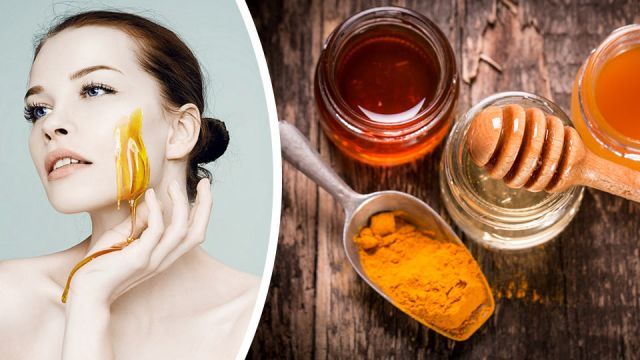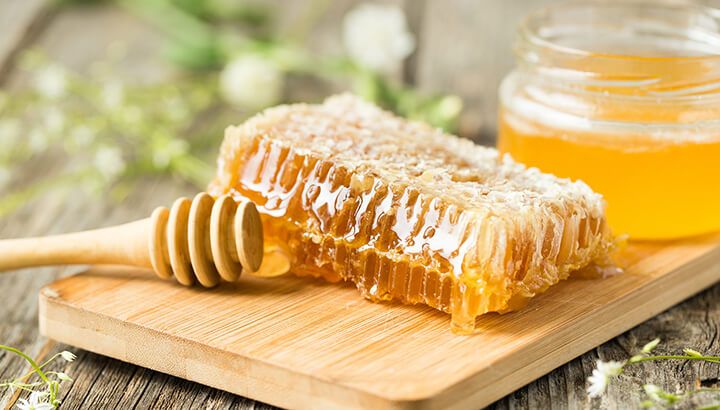
Some matches simply have to be made in heaven. Strawberries and cream. Chips and dip. Sweet potato fries and garlic aioli. You get the idea.
But then come along two very weird ingredients that, when combined, create something truly magical. Two such ingredients are turmeric and honey. Sure, they’re pretty darn awesome on their own — turmeric has legendary anti-inflammatory properties and honey is nature’s true almost-guilt-free sweetener — but together they can provide you with the only facial treatment you’ll ever need.
But first, let’s back the truck up a little. Why would anyone want to put such ridiculous ingredients on their face? What’s all the hype about turmeric and honey? It’s time to put our factoid hats on!
Here are four reasons to put turmeric on your face:
1. Turmeric is anti-inflammatory
Curcumin, the active ingredient in turmeric that also gives it that characteristic deep mustard color, is kind of a big deal when it comes to inflammation. Thousands of studies over the past three decades have shown that turmeric, and more importantly curcumin, is capable of dramatically lowering inflammation both on and within the human body, making it one of the most popular supplements today for treating inflammatory conditions like rheumatoid arthritis, certain chronic diseases, and for alleviating the pain of creaking joints or aching muscles.
So what does this mean for your skin? Well as it happens, many of the most common skin disorders are linked to inflammation — that inflammation could be internal such as in the gut or bowels, or it could be directly on the surface of the skin in response to environmental stressors. Whatever the reason, turmeric’s anti-inflammatory abilities make it an excellent all-around treatment for skin that’s less than ideal!
2. Turmeric can make wrinkles vanish
The wide range of vitamins, minerals and nutrients found in turmeric make it a great way to banish wrinkles before they take over your face! Wrinkles often occur due to a deficiency in certain nutrients or in response to inflammatory precursors — turmeric can help with both, making it one of nature’s great anti-wrinkle creams (when you mix it with something a little less powdery, that is).
3. Turmeric speeds healing

If you’ve got any blemishes, scratches or areas of your face that simply refuse to heal, turmeric might be just the ticket. A clinical trial completed in 2015 found that turmeric cream was easily the most effective treatment for speeding wound healing in women following a Caesarean section. Their wounds healed faster and with less complications, showing that turmeric is a powerful healing agent.
4. Turmeric balances oily skin
To prevent the skin from drying out, subcutaneous sebaceous glands secrete natural oils, thereby helping the epidermis to retain moisture and avoid cracking. Overactive sebaceous glands, however, can lead to excessively oily skin, which can lead to acne, cysts and any number of other skin woes.
Turmeric can help with that. A 2012 study published in the Tropical Journal of Pharmaceutic Research found that patients were able to begin regulating excessive sebum production within four weeks, simply by applying turmeric cream to their skin. This positive effect on oily skin was so pronounced that over the course of three months, turmeric cream was able to lower skin sebum production by a whopping 25 percent.
Here are four reasons to put honey on your face:
1. Honey is antibacterial
Many of the most common skin ailments are caused by bacteria residing on or in our epidermis. Acne, for example, often occurs when the sebaceous glands I discussed earlier become inflamed, allowing bacteria to move in an exacerbate the problem. Then there’s the wide array of icky fungal skin infections, the most infamous of which is athlete’s foot (which isn’t actually limited to your foot, FYI).
Honey to the rescue! Research shows that honey, especially the raw stuff, is a highly effective broad-spectrum antibacterial agent. Simply smearing honey on your skin raises the pH, making it too acidic for most microorganisms to survive. And those that do survive get stuck in the sticky membranes of honey, whereupon they quickly meet their demise.
2. Honey is moisturizing

You might not think it, but honey actually provides a beneficial moisturizing function for your skin. The active enzymes present in raw honey promote the rapid absorption of it’s hydrolyzing molecules into the upper layer of the skin, locking in moisture and ensuring your skin stays fresh and youthful.
3. Honey is nourishing
Honey isn’t just a delicious natural sweetener; it’s also loaded with vitamins, antioxidants and natural enzymes that help you to nourish your skin either from the inside out or the outside in, depending on whether you eat it or smear it on your skin! Supplying your skin with a steady stream of nutrients is all the more important considering the toxins we expose it to every day.
4. Honey cleanses pores
If you’re suffering from clogged pores, blackheads or oily skin, honey can help. The heady combination of antioxidants and antibacterial abilities make it a great choice for entering surface pores, wiping out unwanted microorganisms and nourishing those pores to ensure they stay healthy and bacteria-free into the future.
Turmeric and honey face mask recipe
Enough talk about all the reasons why you should put turmeric and honey on your face — let’s get down to business! Here’s a simple way for you to enjoy all the skin-nourishing benefits of these two awesome ingredients, every day.
Ingredients
- 1 tsp turmeric powder
- 1 tsp raw honey
Instructions
In a small bowl, use a teaspoon or popsicle stick to mix the two ingredients together until roughly combined. If the mixture is too dry, consider adding a few drops of water or a small amount of warm (liquid) organic coconut oil to lube things up a little.
When ready to apply, rinse your face with warm water, pat dry and use your hands to rub the mixture onto as much of your face as you can. Be warned: turmeric can stain clothes, so tread carefully!
Leave the face mask on for around 20 minutes, rinse off with warm water (it’s often easiest to do this in the shower) and lock in the moisture with a small amount of coconut oil.
— Liivi Hess

